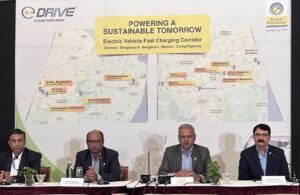India’s leading petroleum company, BPCL has made its entry in EV as it launched its electric fast-charging corridors in South India.
 The company has already installed 25 kW fast chargers in two corridors in the south and its second phase, BPCL is looking at converting 7,000 petrol stations to energy stations in the short to medium term along the Bangalore-Chennai and Bangalore-Mysore-Coorg highway.
The company has already installed 25 kW fast chargers in two corridors in the south and its second phase, BPCL is looking at converting 7,000 petrol stations to energy stations in the short to medium term along the Bangalore-Chennai and Bangalore-Mysore-Coorg highway.
The aim is to provide CCS-2 EV charging stations, placed at ~100 km intervals, and as per PS Ravi, the Executive Director In-Charge of BPCL (Retail), the upcoming charging stations will be primarily targeted towards the electric passenger vehicle segment.
BPCL is addressing three major anxiety factors associated with EVs – range, discovery and time. Range, as we all know is a primary concern with EVs, however, discovery is also important. EV owners who want to drive their vehicles on long-distance road trips are anxious about EV charging locations, and with BPCL is targeting to address this concern by setting up fast-chargers every 100 km.
The third is time. One drawback most EV owners face is the time it takes to charge an electric vehicle and spending 6-8 hours on the highway for a vehicle to charge is not practical. Again, with fast chargers set at certain intervals, BPCL is looking to address the anxiety with regards to the time taken.
These ‘Energy Stations’ aim to offer customers a clean, hygienic and safe location, while also allowing for quick refreshments while the vehicle charges. “In under 30 minutes, our chargers can provide almost 200 km range on EVs”, says the Executive Director.
He adds, “We have chosen the corridor and the petrol stations keeping the safety of customers in mind. And in the coming six months, we aim to set up 200 such corridors and we are planning to invest Rs 500 crore this year for the same.”
However, India is unique and has its own set of challenges. The Bengaluru-Mysuru-Coorg corridor where BPCL is planning to set up charging stations was recently flooded with the heavy rainfall Karnataka received, and electricity and water are not a good combination. This was an aspect BPCL had to address. Another challenge is a power failure.
“All our stations will have generators to provide constant electricity in such unforeseen situations. It will be expensive, but a solution nonetheless. We are also learning and BPCL is already running a pilot project where we are using solar power to generate electricity and this is something we are looking into,” explains Ravi.
In terms of safety aspects, a short circuit at a petrol station can be extremely hazardous because of the amount of fuel stored. Ravi says, “In this regard, we adhere to stringent safety norms governed by the Oil Industry Safety Directorate (OISD) in terms of where fuel is stored and how its dispatched. As for the retail outlets are concerned, they adhere to stringent PESO norms that dictate how a fuel pump needs to be set up and the electric charging stations are also governed by them.”
Apart from EVs and the infrastructure, India is also heading towards Ethanol mixed-fuel, which BPCL is spearheading interaction with the ministry and distilleries. “India has already achieved a 10 percent blend and by April 1, 2023, we are looking at the mix to go up to 20 percent. Existing vehicles are already being tested for this by OEMs and we will get to know soon,” he adds.
BPCL has planned for a complete transition to 20 percent Ethanol-mixed fuel by 2025 and BPCL is ready to receive, store, and deliver. However, challenges need to be addressed and one of the biggest – does India have the capacity to produce so much Ethanol.
Around 85 percent of Ethanol is produced from Sugarcane, which is grown in three states on;y – UP, Maharashtra, and Karnataka. “Transporting Ethanol produced in these three states does not make sense as we will be burning fuel to transport fuel. “However, Ethanol can also be produced from food grains,” says Ravi.
With the support of the government, 130 new plants are being set up across the country to produce Ethanol from these damaged food grains. “These plants will come up in the next two years and the capacity to produce Ethanol will increase substantially and these facilities will have the capacity to produce 700 to 800 crore litres of Ethanol. We have signed agreements with many of them and have fixed the supply-side issue and now, we need to address the demand side of it and this is a job for vehicle OEMs,” says Ravi.

